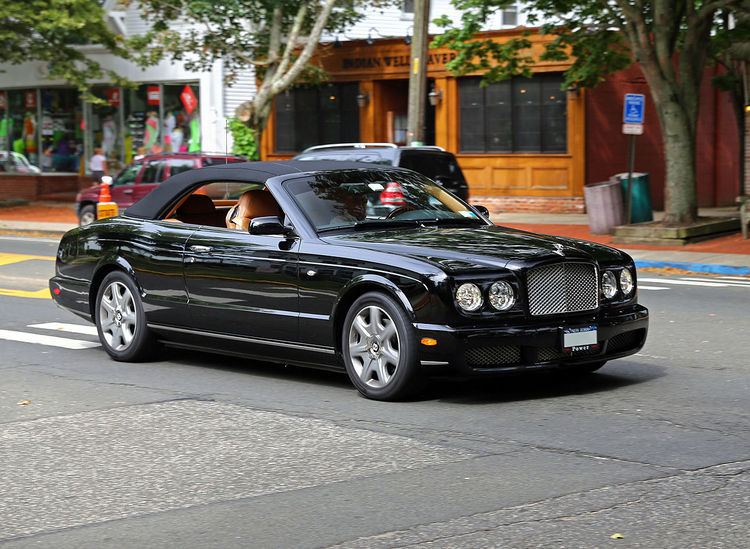Manufacturer Bentley Motors Limited Layout FR layout | Production 1995–2003 | |
 | ||
The Bentley Azure is a large, four seater convertible built by Bentley Motors Limited at its factory in Crewe, England. The model debuted in 1995 on the Bentley Continental R platform and was produced until 2003. After a three-year break a completely new version powered by a significantly updated engine and riding on the newer Arnage platform debuted in 2006. According to 2009 research by internet company Yahoo!, the Azure is the fourth most fuel consuming car on sale in the United Kingdom.
Contents
First generation (1995–2003)
The Azure debuted in March 1995 at the Geneva Motor Show on the platform of the Continental R model, which had been originally launched in 1991. Production only crept to a start, with a mere nine examples finished in the first year – in 1996, after full production had started, no less than 251 Azures were finished. Pininfarina assisted in the two-year process of turning the Continental R into a full four-seater convertible, and also built the shell and soft-top at their factory in Italy, largely from parts sourced in the UK. Final assembly was then carried out at Crewe. A roll-bar was never considered, which necessitated extensive reinforcing of the chassis. At 210 in (5,340 mm) in length and 5,750 pounds (2,610 kg) in weight, the Azure often surprised onlookers with its size and bulk, intended to both convey a sense of "presence" and allow for comfortable seating of four adult passengers.
Power came from the company's stalwart 6.75-litre V8, featuring a single, intercooled Garrett turbocharger and producing in the region of 360 hp – Rolls-Royce and Bentley did not yet give official power numbers at the time of the Azure's introduction. By the time production began in earnest, new engine management from Zytek meant a slight power increase to 385 hp (287 kW; 390 PS) at 4,000 rpm and 750 N·m (553 lb·ft) of torque at 2,000 rpm; power was routed to the rear wheels via a modified, General Motors sourced, four-speed automatic transmission. With a zero to sixty miles per hour time of 6.3 seconds (0–100 km/h in 6.5 s) and a top speed of 241 km/h (150 mph), the Azure was very fast for a car of its size, weight and poor aerodynamic profile.
Owing to the limited space and workforce at Bentley's Crewe factory, the Azure's thick, powered convertible top was designed and manufactured by Pininfarina, which significantly added to the vehicle's cost. New in 1995, the Azure was priced at $347,645 – $36,355 more than the Continental R on which it was based.
From 1999 through the end of production, the Azure was also available in "Mulliner" trim, which added special bespoke trim and additional equipment and allowed the buyer the option for further customisation during the build-process; pricing varied by car, as equipment could be significantly different from one to the next depending on customer requests.
One of limited editions included '2000 Symbolic Edition', an only 4-made Mulliner commission.
*stated by Pininfarina production records
**From 2 varying documents, newer data used
Second generation (2006–2009)
Volkswagen purchased Bentley from Vickers in 1998, three years into production of the Mark 1 model. Volkswagen executives decided to keep the then-current Azure in production until 2003, then release its successor at a later date. Production of the new Azure began for the 2006 model year.
Now based on the Arnage platform, power came from the then-current variant of the Bentley turbocharged V8 making 450 hp (340 kW) and 645 lb·ft (875 N·m) of torque. New Arnage was designed for the BMW 4.4-liter engine. However, due to strained relationships between the two manufacturers, Volkswagen was forced to significantly re-work the "original" 6.75-liter Rolls-Royce/Bentley V8 in 2001, including a switch from the old single-turbo system to a modern twin-turbocharger setup, reducing turbo-lag and increasing horsepower output. A new, model-specific six-speed automatic transmission fed power to the rear wheels.
Bentley claims a 0 to 60-mile-per-hour time of 5.6 seconds and a top speed of 168 mph (270 km/h), slightly faster than the previous edition and still very good for a vehicle of this size and weight.
The United States Department of Energy lists Bentley Azure as the least fuel-efficient car in its class with only 9 miles per US gallon (26 L/100 km; 11 mpg‑imp) city and 15 miles per US gallon (16 L/100 km; 18 mpg‑imp) highway rates.
Azure T (2009–2010)
The "T" is a higher performance version of the Bentley Azure. Styling changes include 8.5J x 20-inch five-spoke, two-piece alloy wheels with 255/40 ZR20 Pirelli P Zero tyres, 'Le Mans' lower front wing air vents, dark-tinted upper and lower grilles, 'jewel' fuel filler cap (made from billet aluminium), door mirror mountings finished in body colour. The exterior styling was inspired from Bentley Mark VI.
Audio system includes large display audio head unit with Secure Digital (SD) memory card slot, iPod/USB/3.5 mm AUX interface; with optional 'Naim for Bentley' 10-speaker, 1100W audio system. Electronic Stability Programme, Tire Pressure Monitoring System are now standard equipment.
The twin turbocharged engine is rated 507 PS (373 kW; 500 hp) and 1,000 N·m (740 lb·ft) torque. It has a 0–60 miles per hour time of 5.1 seconds (0–100 km/h at 5.5 seconds), 0–100 mph time in 12.1 seconds (0–160 km/h in 12.0 seconds) and a top speed of 179 mph (288 km/h).
The car was unveiled at the LA Auto Show.
The Azure had no immediate successor. However, at the 2014 L.A. Auto Show, Bentley unveiled a concept car built on the Mulsanne platform that follows the same formula as the two generations of Azure that proceeded it. Bentley did not use the Azure name again with the concept, simply calling it the Bentley Grand Convertible.
